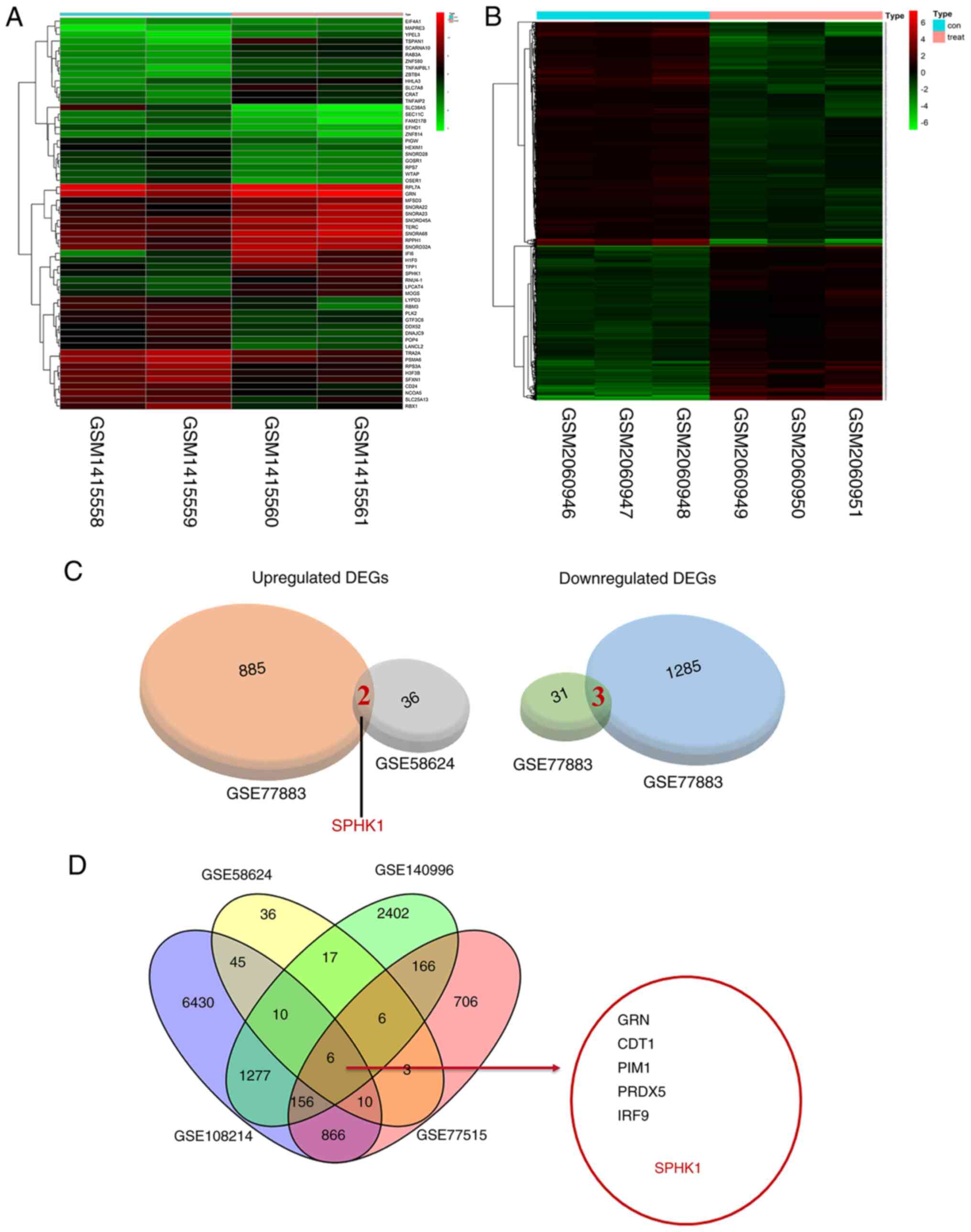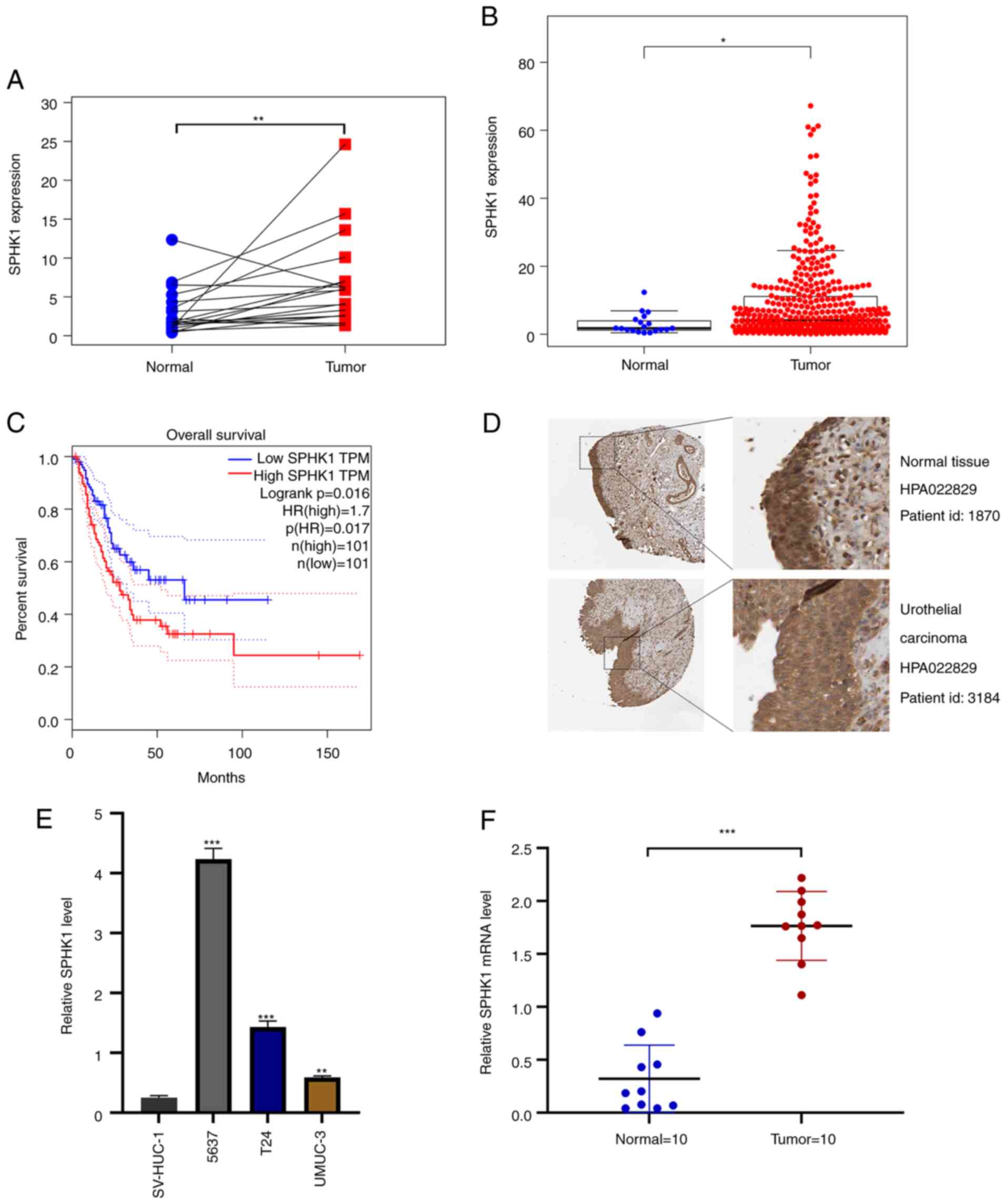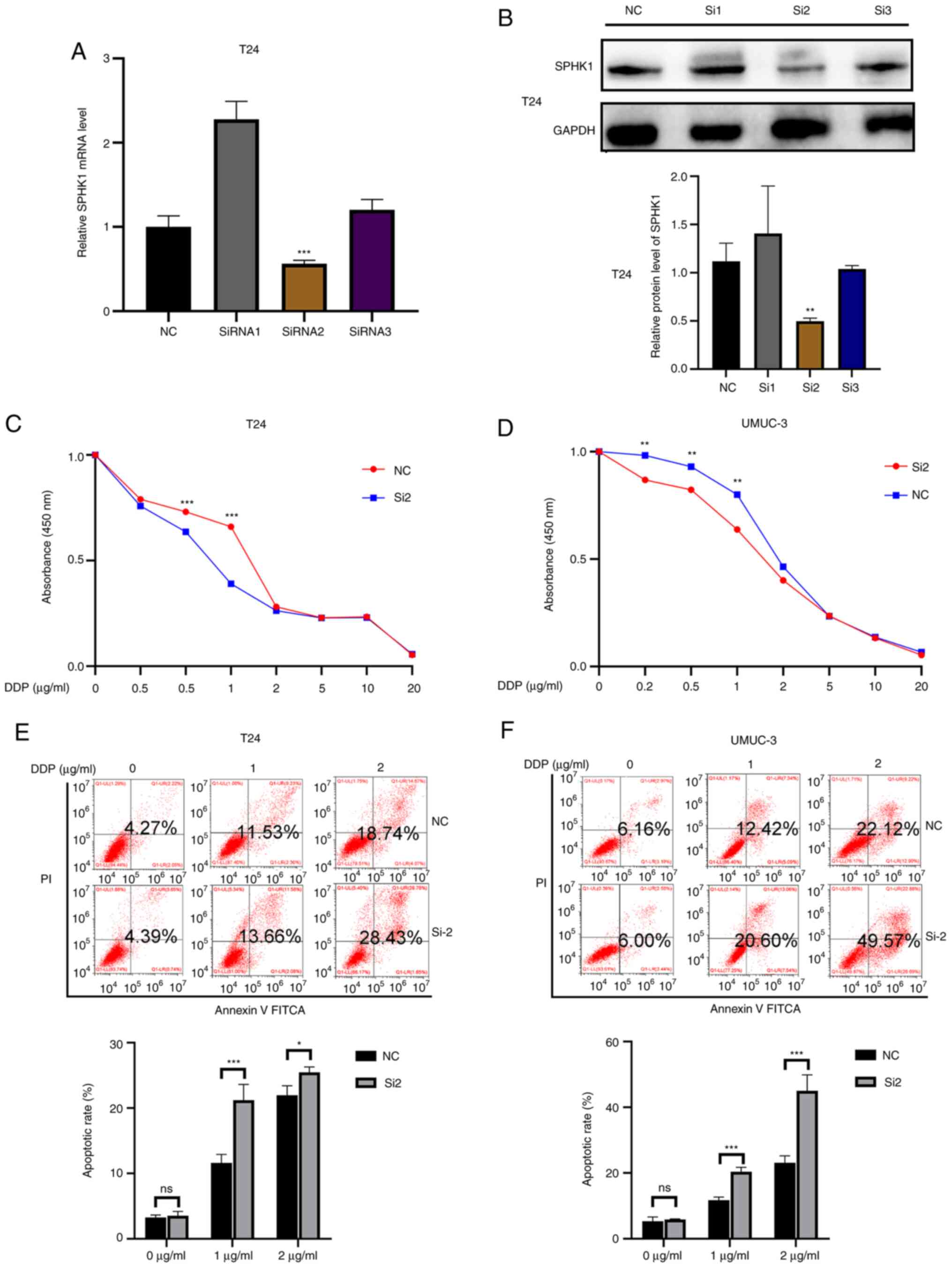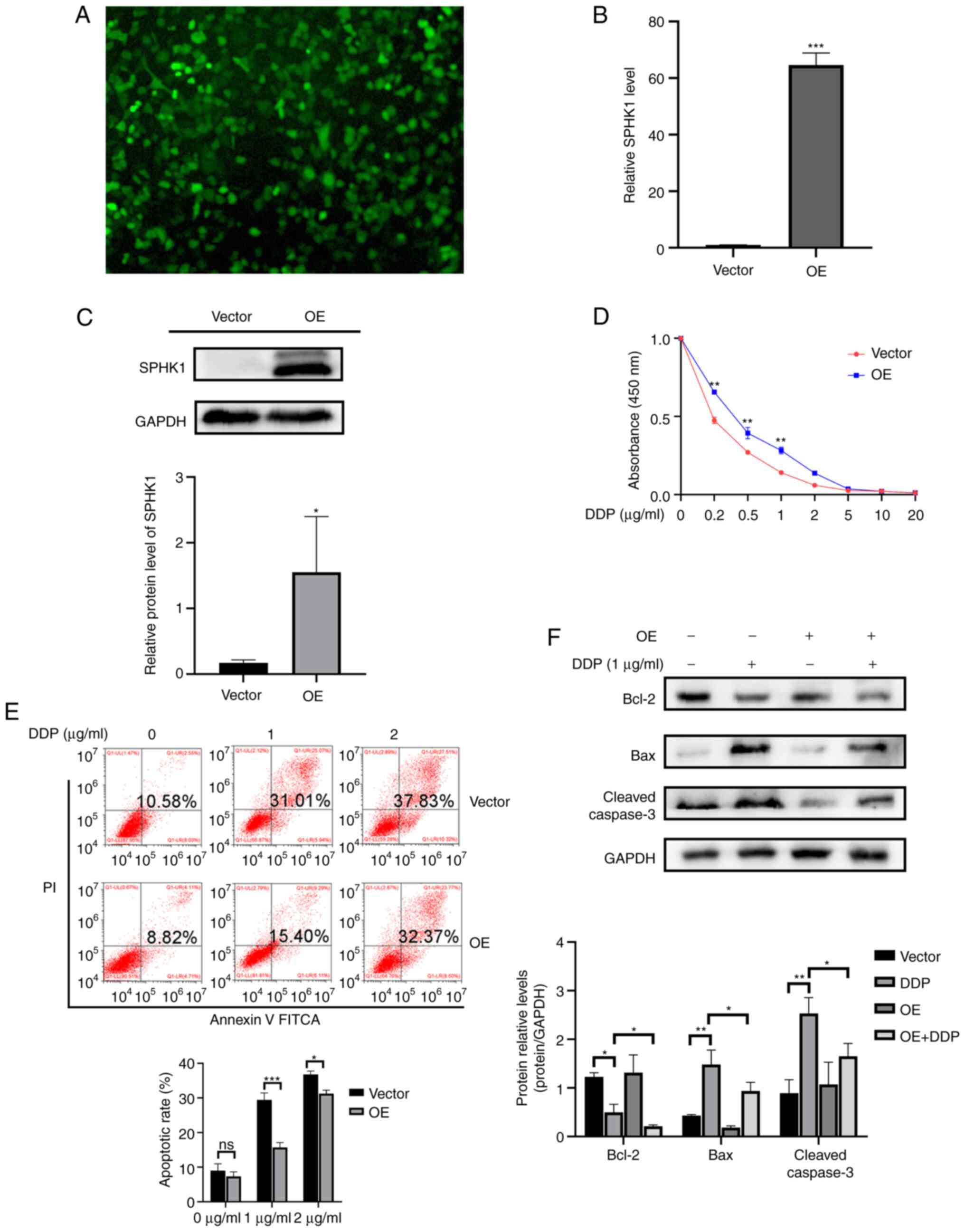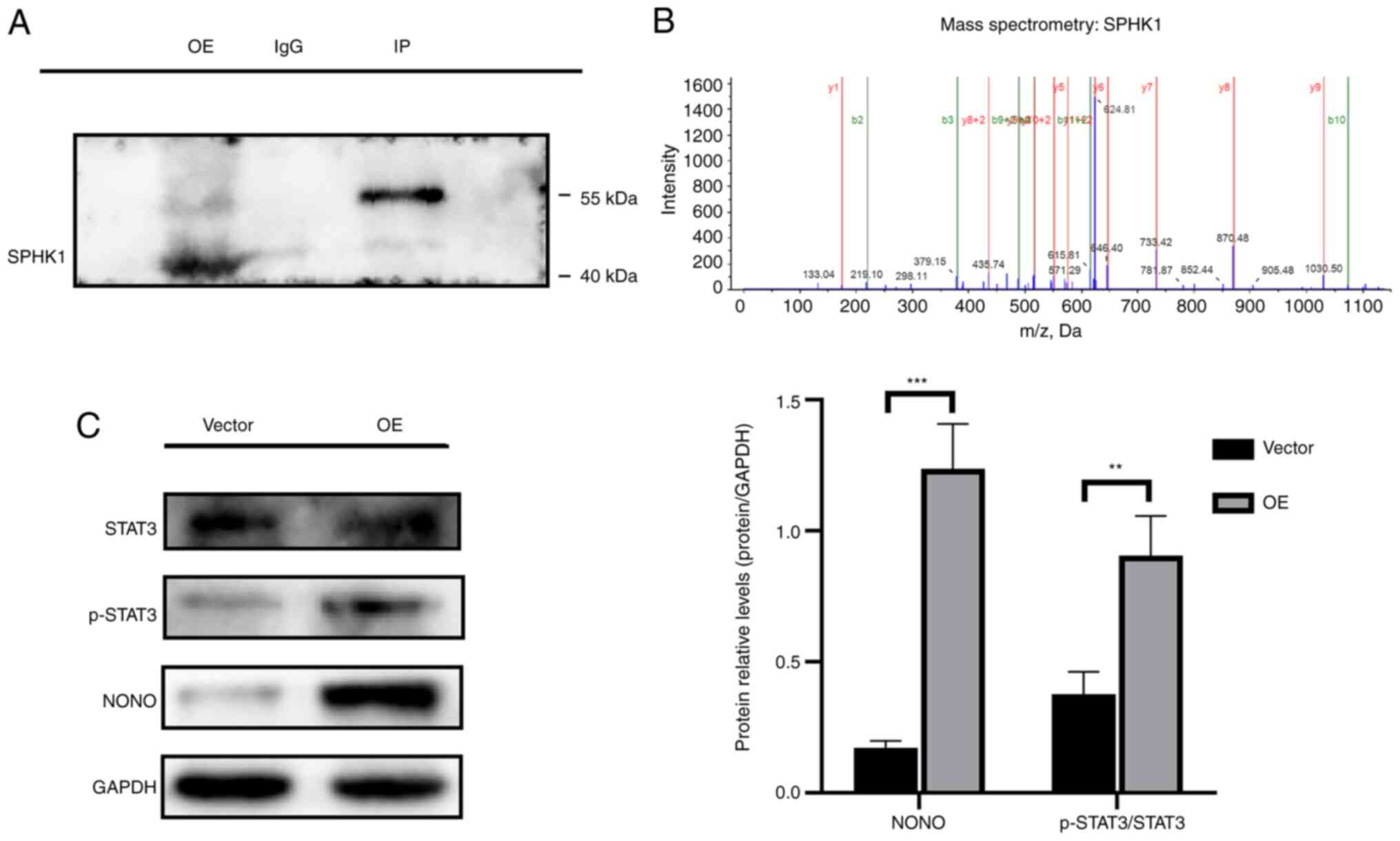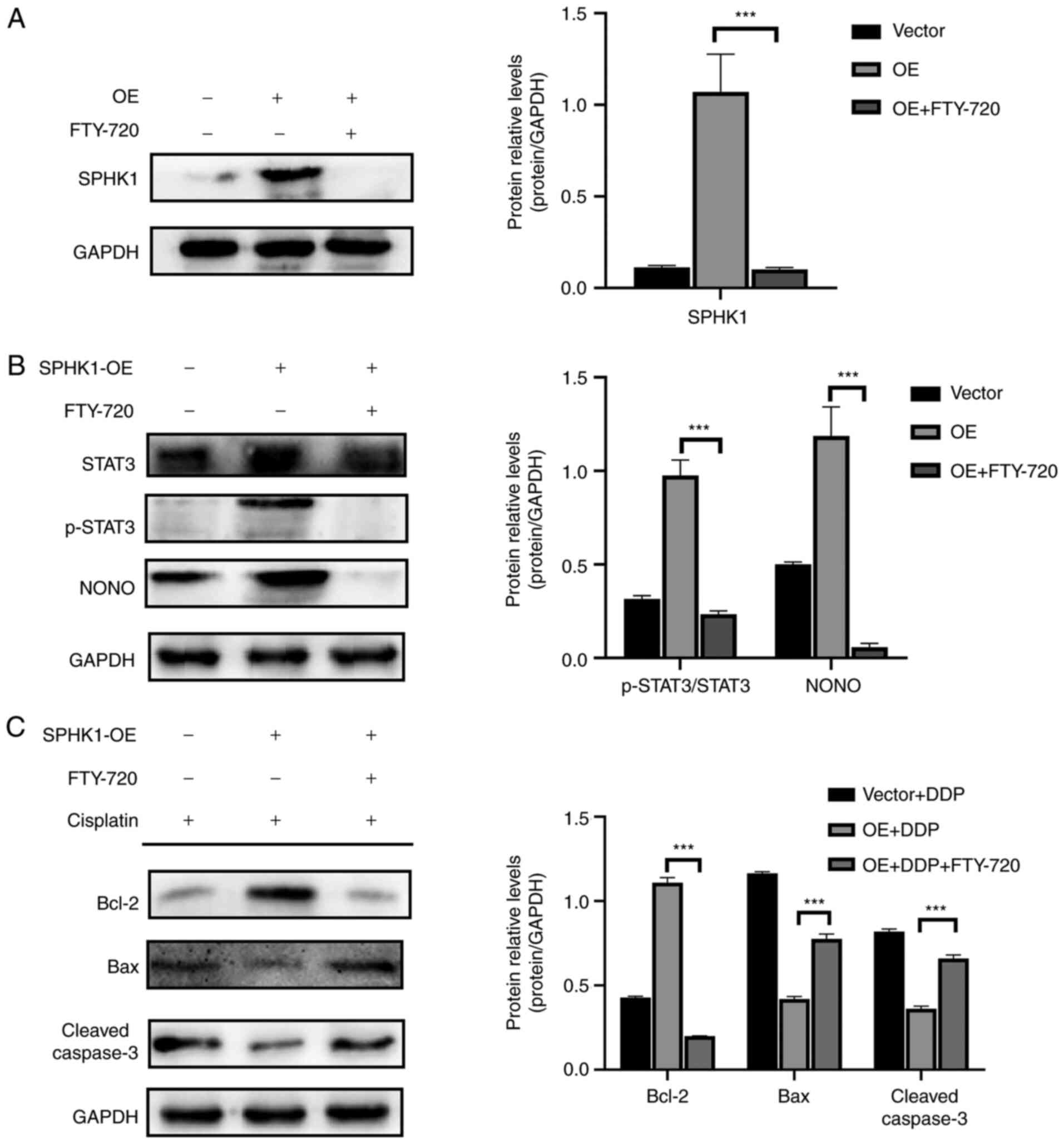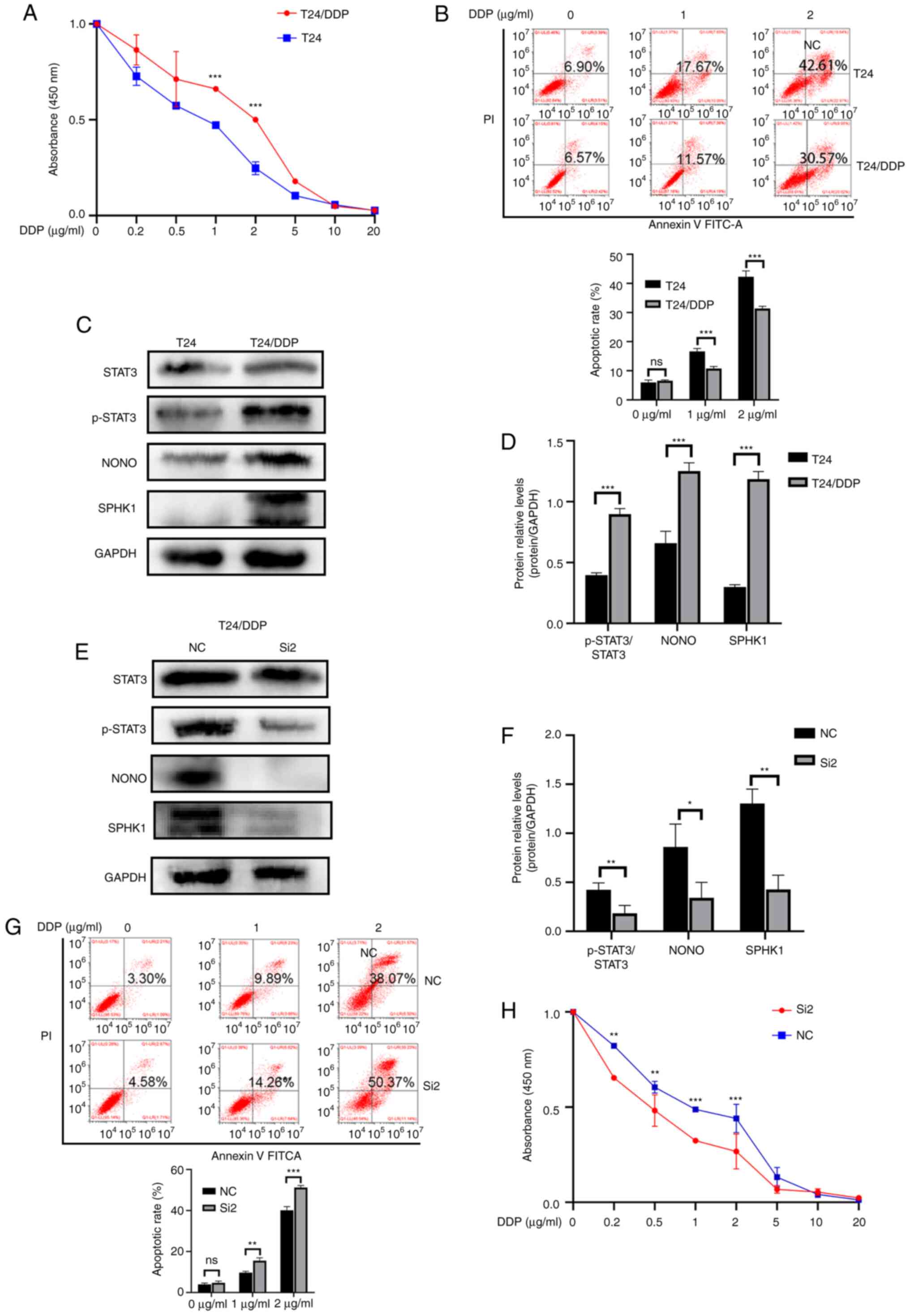|
1
|
Siegel RL, Miller KD and Jemal A: Cancer
statistics, 2020. CA Cancer J Clin. 70:7–30. 2020. View Article : Google Scholar
|
|
2
|
Witjes JA, Bruins HM, Cathomas R, Compérat
EM, Cowan NC, Gakis G, Hernández V, Linares Espinós E, Lorch A,
Neuzillet Y, et al: European association of urology guidelines on
muscle-invasive and metastatic bladder cancer: Summary of the 2020
guidelines. Eur Urol. 79:82–104. 2021. View Article : Google Scholar
|
|
3
|
Choi W, Porten S, Kim S, Willis D, Plimack
ER, Hoffman-Censits J, Roth B, Cheng T, Tran M, Lee IL, et al:
Identification of distinct basal and luminal subtypes of
muscle-invasive bladder cancer with different sensitivities to
frontline chemotherapy. Cancer Cell. 25:152–165. 2014. View Article : Google Scholar
|
|
4
|
Shah JB, McConkey DJ and Dinney CP: New
strategies in muscle-invasive bladder cancer: On the road to
personalized medicine. Clin Cancer Res. 17:2608–2612. 2011.
View Article : Google Scholar
|
|
5
|
Nguyen AV, Wu YY and Lin EY: STAT3 and
sphingosine-1-phosphate in inflammation-associated colorectal
cancer. World J Gastroenterol. 20:10279–10287. 2014. View Article : Google Scholar
|
|
6
|
Maceyka M, Harikumar KB, Milstien S and
Spiegel S: Sphingosine-1-phosphate signaling and its role in
disease. Trends Cell Biol. 22:50–60. 2012. View Article : Google Scholar
|
|
7
|
Pyne S, Edwards J, Ohotski J and Pyne NJ:
Sphingosine 1-phosphate receptors and sphingosine kinase 1: Novel
biomarkers for clinical prognosis in breast, prostate, and
hematological cancers. Front Oncol. 2:1682012. View Article : Google Scholar
|
|
8
|
Pitson SM, Powell JA and Bonder CS:
Regulation of sphingosine kinase in hematological malignancies and
other cancers. Anticancer Agents Med Chem. 11:799–809. 2011.
View Article : Google Scholar
|
|
9
|
Vadas M, Xia P, McCaughan G and Gamble J:
The role of sphingosine kinase 1 in cancer: Oncogene or
non-oncogene addiction? Biochim Biophys Acta. 1781:442–447. 2008.
View Article : Google Scholar
|
|
10
|
Nemoto S, Nakamura M, Osawa Y, Kono S,
Itoh Y, Okano Y, Murate T, Hara A, Ueda H, Nozawa Y and Banno Y:
Sphingosine kinase isoforms regulate oxaliplatin sensitivity of
human colon cancer cells through ceramide accumulation and Akt
activation. J Biol Chem. 284:10422–10432. 2009. View Article : Google Scholar
|
|
11
|
Shen Z, Feng X, Fang Y, Li Y, Li Z, Zhan
Y, Lin M, Li G, Ding Y and Deng H: POTEE drives colorectal cancer
development via regulating SPHK1/p65 signaling. Cell Death Dis.
10:8632019. View Article : Google Scholar
|
|
12
|
Kameyama K, Horie K, Mizutani K, Kato T,
Fujita Y, Kawakami K, Kojima T, Miyazaki T, Deguchi T and Ito M:
Enzalutamide inhibits proliferation of gemcitabine-resistant
bladder cancer cells with increased androgen receptor expression.
Int J Oncol. 50:75–84. 2017. View Article : Google Scholar
|
|
13
|
Tanaka N, Kosaka T, Miyazaki Y, Mikami S,
Niwa N, Otsuka Y, Minamishima YA, Mizuno R, Kikuchi E, Miyajima A,
et al: Acquired platinum resistance involves epithelial to
mesenchymal transition through ubiquitin ligase FBXO32
dysregulation. JCI Insight. 1:e836542016. View Article : Google Scholar
|
|
14
|
Sarin N, Engel F, Rothweiler F, Cinatl J,
Michaelis M, Frötschl R, Fröhlich H and Kalayda GV: Key players of
cisplatin resistance: Towards a systems pharmacology approach. Int
J Mol Sci. 19:7672018. View Article : Google Scholar
|
|
15
|
Wantoch von Rekowski K, König P, Henze S,
Schlesinger M, Zawierucha P, Januchowski R and Bendas G: The impact
of integrin-mediated matrix adhesion on cisplatin resistance of W1
ovarian cancer cells. Biomolecules. 9:7882019. View Article : Google Scholar
|
|
16
|
Chisholm CL, Wang H, Wong AH,
Vazquez-Ortiz G, Chen W, Xu X and Deng CX: Ammonium
tetrathiomolybdate treatment targets the copper transporter ATP7A
and enhances sensitivity of breast cancer to cisplatin. Oncotarget.
7:84439–84452. 2016. View Article : Google Scholar
|
|
17
|
Livak KJ and Schmittgen TD: Analysis of
relative gene expression data using real-time quantitative PCR and
the 2(-Delta Delta C(T)) method. Methods. 25:402–408. 2001.
View Article : Google Scholar
|
|
18
|
Huwiler A and Zangemeister-Wittke U: The
sphingosine 1-phosphate receptor modulator fingolimod as a
therapeutic agent: Recent findings and new perspectives. Pharmacol
Ther. 185:34–49. 2018. View Article : Google Scholar
|
|
19
|
Lim KG, Tonelli F, Li Z, Lu X, Bittman R,
Pyne S and Pyne NJ: FTY720 analogues as sphingosine kinase 1
inhibitors: Enzyme inhibition kinetics, allosterism, proteasomal
degradation, and actin rearrangement in MCF-7 breast cancer cells.
J Biol Chem. 286:18633–18640. 2011. View Article : Google Scholar
|
|
20
|
Azuma H, Takahara S, Horie S, Muto S,
Otsuki Y and Katsuoka Y: Induction of apoptosis in human bladder
cancer cells in vitro and in vivo caused by FTY720 treatment. J
Urol. 169:2372–2377. 2003. View Article : Google Scholar
|
|
21
|
Sun Z, Niu S, Xu F, Zhao W, Ma R and Chen
M: CircAMOTL1 promotes tumorigenesis through miR-526b/SIK2 axis in
cervical cancer. Front Cell Dev Biol. 8:5681902020. View Article : Google Scholar
|
|
22
|
Chen M, Zhuang C, Liu Y, Li J, Dai F, Xia
M, Zhan Y, Lin J, Chen Z, He A, et al: Tetracycline-inducible shRNA
targeting antisense long non-coding RNA HIF1A-AS2 represses the
malignant phenotypes of bladder cancer. Cancer Lett. 376:155–164.
2016. View Article : Google Scholar
|
|
23
|
Chen M, Wei X, Shi X, Lu L, Zhang G, Huang
Y and Hou J: LncRNA HIF1A-AS2 accelerates malignant phenotypes of
renal carcinoma by modulating miR-30a-5p/SOX4 axis as a ceRNA.
Cancer Biol Med. 18:587–603. 2021. View Article : Google Scholar
|
|
24
|
Cuvillier O, Pirianov G, Kleuser B, Vanek
PG, Coso OA, Gutkind S and Spiegel S: Suppression of
ceramide-mediated programmed cell death by sphingosine-1-phosphate.
Nature. 381:800–803. 1996. View
Article : Google Scholar
|
|
25
|
Powell JA, Lewis AC, Zhu W, Toubia J,
Pitman MR, Wallington-Beddoe CT, Moretti PA, Iarossi D, Samaraweera
SE, Cummings N, et al: Targeting sphingosine kinase 1 induces
MCL1-dependent cell death in acute myeloid leukemia. Blood.
129:771–782. 2017. View Article : Google Scholar
|
|
26
|
Bonhoure E, Lauret A, Barnes DJ, Martin C,
Malavaud B, Kohama T, Melo JV and Cuvillier O: Sphingosine kinase-1
is a downstream regulator of imatinib-induced apoptosis in chronic
myeloid leukemia cells. Leukemia. 22:971–979. 2008. View Article : Google Scholar
|
|
27
|
Ruckhäberle E, Rody A, Engels K, Gaetje R,
von Minckwitz G, Schiffmann S, Grösch S, Geisslinger G, Holtrich U,
Karn T and Kaufmann M: Microarray analysis of altered sphingolipid
metabolism reveals prognostic significance of sphingosine kinase 1
in breast cancer. Breast Cancer Res Treat. 112:41–52. 2008.
View Article : Google Scholar
|
|
28
|
Pchejetski D, Golzio M, Bonhoure E, Calvet
C, Doumerc N, Garcia V, Mazerolles C, Rischmann P, Teissié J,
Malavaud B and Cuvillier O: Sphingosine kinase-1 as a chemotherapy
sensor in prostate adenocarcinoma cell and mouse models. Cancer
Res. 65:11667–11675. 2005. View Article : Google Scholar
|
|
29
|
Gerstberger S, Hafner M and Tuschl T: A
census of human RNA-binding proteins. Nat Rev Genet. 15:829–845.
2014. View
Article : Google Scholar
|
|
30
|
Fox AH and Lamond AI: Paraspeckles. Cold
Spring Harb Perspect Biol. 2:a0006872010. View Article : Google Scholar
|
|
31
|
Feng P, Li L, Deng T, Liu Y, Ling N, Qiu
S, Zhang L, Peng B, Xiong W, Cao L, et al: NONO and tumorigenesis:
More than splicing. J Cell Mol Med. 24:4368–4376. 2020. View Article : Google Scholar
|
|
32
|
Schiffner S, Zimara N, Schmid R and
Bosserhoff AK: p54nrb is a new regulator of progression of
malignant melanoma. Carcinogenesis. 32:1176–1182. 2011. View Article : Google Scholar
|
|
33
|
Cheng R, Zhu S, Guo S, Min L, Xing J, Guo
Q, Li P and Zhang S: Downregulation of NONO induces apoptosis,
suppressing growth and invasion in esophageal squamous cell
carcinoma. Oncol Rep. 39:2575–2583. 2018.
|
|
34
|
Xie R, Chen X, Cheng L, Huang M, Zhou Q,
Zhang J, Chen Y, Peng S, Chen Z, Dong W, et al: NONO inhibits
lymphatic metastasis of bladder cancer via alternative splicing of
SETMAR. Mol Ther. 29:291–307. 2021. View Article : Google Scholar
|
|
35
|
Liang J, Nagahashi M, Kim EY, Harikumar
KB, Yamada A, Huang WC, Hait NC, Allegood JC, Price MM, Avni D, et
al: Sphingosine-1-phosphate links persistent STAT3 activation,
chronic intestinal inflammation, and development of
colitis-associated cancer. Cancer Cell. 23:107–120. 2013.
View Article : Google Scholar
|
|
36
|
Lee H, Deng J, Kujawski M, Yang C, Liu Y,
Herrmann A, Kortylewski M, Horne D, Somlo G, Forman S, et al:
STAT3-induced S1PR1 expression is crucial for persistent STAT3
activation in tumors. Nat Med. 16:1421–1428. 2010. View Article : Google Scholar
|
|
37
|
Bosch-Barrera J, Queralt B and Menendez
JA: Targeting STAT3 with silibinin to improve cancer therapeutics.
Cancer Treat Rev. 58:61–69. 2017. View Article : Google Scholar
|
|
38
|
Zhu H, Luo H, Zhang W, Shen Z, Hu X and
Zhu X: Molecular mechanisms of cisplatin resistance in cervical
cancer. Drug Des Devel Ther. 10:1885–1895. 2016. View Article : Google Scholar
|
|
39
|
Pabla N, Murphy RF, Liu K and Dong Z: The
copper transporter Ctr1 contributes to cisplatin uptake by renal
tubular cells during cisplatin nephrotoxicity. Am J Physiol Renal
Physiol. 296:F505–F511. 2009. View Article : Google Scholar
|
|
40
|
Galluzzi L, Vitale I, Michels J, Brenner
C, Szabadkai G, Harel-Bellan A, Castedo M and Kroemer G: Systems
biology of cisplatin resistance: Past, present and future. Cell
Death Dis. 5:e12572014. View Article : Google Scholar
|
|
41
|
Li S, Li C, Jin S, Liu J, Xue X, Eltahan
AS, Sun J, Tan J, Dong J and Liang XJ: Overcoming resistance to
cisplatin by inhibition of glutathione S-transferases (GSTs) with
ethacraplatin micelles in vitro and in vivo. Biomaterials.
144:119–129. 2017. View Article : Google Scholar
|
|
42
|
Henrique R, Nunes SP and Jerónimo C: MSH2
expression and resistance to cisplatin in muscle-invasive bladder
cancer: A mix of progress and challenges. Eur Urol. 75:251–252.
2019. View Article : Google Scholar
|
|
43
|
Tanida S, Mizoshita T, Ozeki K, Tsukamoto
H, Kamiya T, Kataoka H, Sakamuro D and Joh T: Mechanisms of
cisplatin-induced apoptosis and of cisplatin sensitivity: Potential
of BIN1 to Act as a potent predictor of cisplatin sensitivity in
gastric cancer treatment. Int J Surg Oncol. 2012:8628792012.
|
|
44
|
Viktorsson K, Ekedahl J, Lindebro MC,
Lewensohn R, Zhivotovsky B, Linder S and Shoshan MC: Defective
stress kinase and Bak activation in response to ionizing radiation
but not cisplatin in a non-small cell lung carcinoma cell line. Exp
Cell Res. 289:256–264. 2003. View Article : Google Scholar
|
|
45
|
Adams JM: Ways of dying: Multiple pathways
to apoptosis. Genes Dev. 17:2481–2495. 2003. View Article : Google Scholar
|
|
46
|
Kunkel TA and Erie DA: DNA mismatch
repair. Annu Rev Biochem. 74:681–710. 2005. View Article : Google Scholar
|
|
47
|
Vaisman A, Varchenko M, Umar A, Kunkel TA,
Risinger JI, Barrett JC, Hamilton TC and Chaney SG: The role of
hMLH1, hMSH3, and hMSH6 defects in cisplatin and oxaliplatin
resistance: Correlation with replicative bypass of platinum-DNA
adducts. Cancer Res. 58:3579–3585. 1998.
|
|
48
|
Tseng-Rogenski SS, Hamaya Y, Choi DY and
Carethers JM: Interleukin 6 alters localization of hMSH3, leading
to DNA mismatch repair defects in colorectal cancer cells.
Gastroenterology. 148:579–589. 2015. View Article : Google Scholar
|
|
49
|
Rocha C, Silva MM, Quinet A, Cabral-Neto
JB and Menck C: DNA repair pathways and cisplatin resistance: An
intimate relationship. Clinics (Sao Paulo). 73(Suppl 1): e478s2018.
View Article : Google Scholar
|
|
50
|
Johnson N, Johnson SF, Yao W, Li YC, Choi
YE, Bernhardy AJ, Wang Y, Capelletti M, Sarosiek KA, Moreau LA, et
al: Stabilization of mutant BRCA1 protein confers PARP inhibitor
and platinum resistance. Proc Natl Acad Sci USA. 110:17041–17046.
2013. View Article : Google Scholar
|















